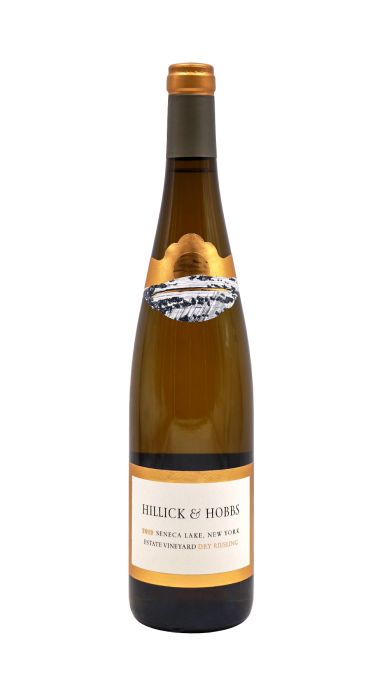Need Help Finding the right wine?
Your personal wine consultant will assist you with buying, managing your collection, investing in wine, entertaining and more.
By continuing, you agree to our privacy policy, consent to cookies, and confirm you are 21 or older.
I have read and agree to the Privacy Policy and Terms of Service.
YOU MUST BE 21 OR OLDER TO CONTINUE
NYC, Long Island and The Hamptons Receive Free Delivery on Orders $300+
Cool Wine Shippers Now Available.
Checkout using your account
Checkout as a new customer
Creating an account has many benefits:

2019 Hillick & Hobbs Estate Vineyard Dry Riesling
94 JS
From the critics:
90 WS
James Suckling | 94 JS
| Type of Wine | New York White |
|---|---|
| Varietal |
Riesling
: It has been 587 years since the official “birth” of Riesling, the Noble grape variety of Germany. In that time, this white grape has seen exponential growth and popularity worldwide. Riesling has traveled beyond the Rhine River, where it is thought to have originated, spreading throughout Germany, Austria and Alsace, Australia, New Zealand and California. New World adaptations may have helped bring the varietal into the global spotlight, but its ancestral home and greatest reflection of terroir remains in Germany. As aforementioned, the first recorded mention of the varietal appeared in the 1435 sale of several Riesling vines to German Count, John IV of Katzenelnbogen. Prior this transaction, the history of Riesling remains unclear, other than it first inhabiting the Rhine River region, which runs throughout parts of Germany, France, Austria and Switzerland. In 1998, scientists in Austria, using DNA technology, were able to determine that Riesling is the progeny of Heunisch Weiss, otherwise known as Gouais Blanc. Said to be a commoner among superior grape varietals, Gouais Blanc is ancient, originated in Germany and has sired some of the greatest varietals in the world, including Chardonnay, Semillon, Gamay noir, Melon and Aligote. The small, round white-green berries of Riesling turn a pretty gold color, often with lenticels (pore-like structures, resembling freckles) when ripe. Vines can vary significantly from weak to moderately vigorous depending on the climatic region, soil characteristics and moisture availability. They are adaptable to a wide range of soil types making it quite dynamic and versatile. One of Riesling’s most unique and celebrated qualities is its vibrant expression of terroir. This “sense of place” enables the particular elements of the soil and microclimate to be uniquely expressed through the wine itself, allowing this globetrotting varietal to flourish in similar winegrowing conditions around the world. Riesling has found success and popularity in California and the Finger Lakes of New York, Australia, New Zealand, France, Hungary and South Africa. However, it reaches its true zenith in the Rhine River Valley. Mosel, Pfalz and Rheingau are the key winegrowing locations in Germany, where the climates are cool with low average temperatures and with the bulk of rainfall occurring during the summer. The vines of Riesling thrive here, in heat-retaining, stony soils on steep, south-facing slopes along the river valleys where they find optimal sunlight and natural growing conditions. Austria and Alsace (France) share similar climatic influences and terroir due to the proximity of the Rhine River. Their winegrowing industries have been greatly impacted by the Riesling grape varietal. The commonly misunderstood Riesling grape varietal produces wines that are quite austere when young, making many wine drinkers wary of them. A fine Riesling almost demands time in the bottle. In good vintages, Riesling can last several decades and rival the finest whites in the world. At a glimpse Riesling may seem simple, but is actually rather complex. Riesling can be harvested early or late, vinified in many ways and can range from dry to very sweet. The five types of Riesling are Kabinett (bone dry to off-dry) Spatlese (sweet) Auslese (sweeter) Beerenauslese (very sweet) Trockenbeerenauslese (sweetest). Thanks to its naturally high acidity, it is a supremely agreeable drinker that will please just about any palate. From tingly-dry, steely-lemon to refreshingly green apple, peach, pear and grapefruit to honeyed and luscious apricot; the myriad of flavor profiles of Riesling is impressive. The Noble Riesling grape may be complex, might be misunderstood and may be more obscure than other white varietals, but is one that produces some of the most fascinating, multifaceted and unique wines in the world. |
| Country |
US
: As one of the most prolific and innovative wine regions in the world, America is a joy to explore. Most wine connoisseurs will agree that the nation's finest and most compelling wines are being produced today, which means that we have front-row seats to one of the most inspirational stories in wine history. While other regions tend to focus on specific wine styles and have somewhat strict rules as to which varietals you could grow, areas like California have few such restrictions in place. As a result, creative visionaries behind America's most reputable estates have been able to develop compelling, unique, and innovative styles, with a level of terroir expression that rivals even France's largest giants. |
| Region | New York |
| Producer | Hillick & Hobbs |
|---|
Need Help Finding the right wine?
Your personal wine consultant will assist you with buying, managing your collection, investing in wine, entertaining and more.